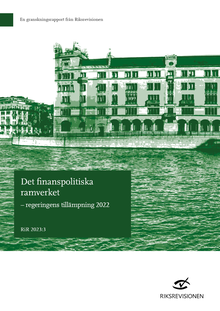Signification reduction in fiscal space with new calculation method
The fiscal policy proposed by the Government and decided by the Riksdag is based on a new calculation method that gives a considerably bleaker picture of the state of public finances. The Government did not inform the Riksdag of the change.

Photo: Fotovoyager
The Swedish National Audit Office (Swedish NAO) has audited the Government’s proposed fiscal policy in the fiscal policy bills in 2022. The overall conclusion is that it has not been reported in accordance with the fiscal policy framework.
The Swedish NAO in particular contests the Government’s change of method for calculating the structural budget balance without informing the Riksdag about the change and its consequences. Under the new method, fiscal policy appears less restrictive than it would have been under the previous method. The Swedish NAO’s audit shows that the fiscal space for 2023 would have been about SEK 55 billion larger with the previous method.
“We do not address whether the new method is better or worse, because we do not have the information needed to make such an assessment; we note that it gives a different picture of the state of public finances for 2023. It should have been clearly presented, especially given that it could potentially affect the interaction with monetary policy and the Riksbank’s assessment of a suitable level of the key interest rate,” says Auditor General Helena Lindberg.
Under the fiscal policy framework, the structural budget balance shall be calculated using accepted methods. What is considered an accepted method is not specified, but the Government and its expert agencies, the National Financial Management Authority and the National Institute of Economic Research, have used similar methods in recent years.
“We consider that the Government’s change of method is a departure from the accepted method of calculating the structural budget balance. Now there is no common method for assessing the state and progress of public finances. This is a serious matter,” says Håkan Jönsson, head of unit at the Swedish National Audit Office.
For several years, the Swedish NAO has criticised the Government for not clearly reporting why its forecasts for the structural budget balance differ from the forecasts of the expert agencies. Since the agencies are not applying the new calculation method, comparisons between the Government and expert agency forecasts are now more difficult to make. This, in turn, complicates the Riksdag’s and others’ assessments of the fiscal policy direction.
Furthermore, the Swedish NAO notes that the Government is unclear in its assessment of the fiscal policy direction.
Recommendations
The Swedish National Audit Office recommends that the Government:
- take the initiative to ensure that an accepted method is once again established for the Government, the National Financial Management Authority and the National Institute of Economic Research to calculate the structural budget balance
- increase transparency concerning the direction of fiscal policy in the budget bills so as to make it clear what the assessment is based on
- improve the forecast comparisons in the budget bills
- consider lowering the expenditure ceiling if the need for margins becomes smaller than feared as a result of the fiscal policy risks
- develop the regulations on how fiscal policy should interact with monetary policy in connection with the next review of the surplus target.
Press contact: Olle Castelius, phone: +46 8-5171 40 04.
Presskontakt: Olle Castelius , telefon: 08-5171 42 06.
Share in social media and by e-mail
Contact form
Send your questions or comments via the form below and we will make sure that they reach the right member of staff. Please state if your question concerns the information on this particular page.


